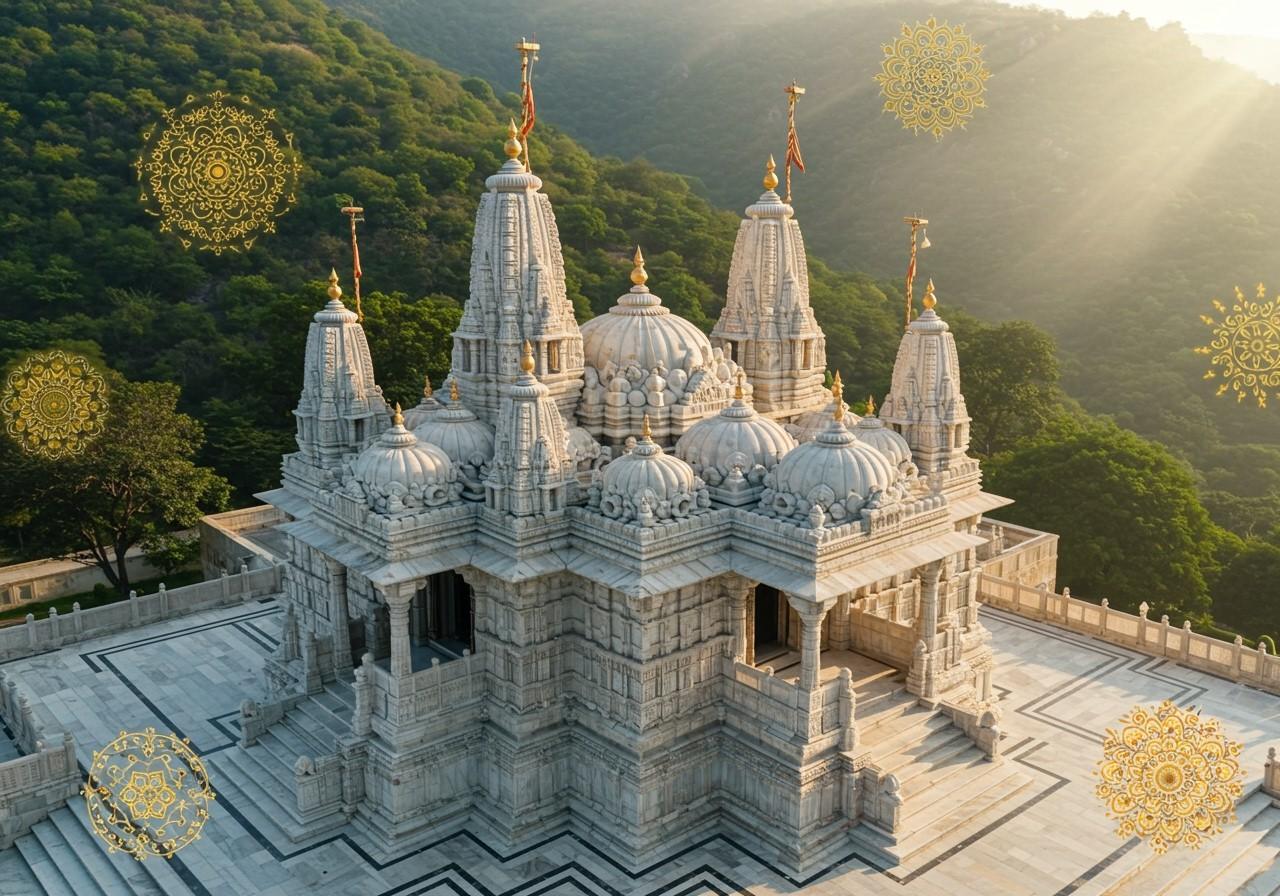
Nestled in the serene hills of Mount Abu, Rajasthan, the Dilwara Temples stand as an architectural marvel and a beacon of Jain spirituality. This blog post delves into their significance, history, visitor information, and nearby attractions to help you plan a meaningful visit.
Historical Background and Architectural Significance
The Dilwara Temples, constructed between the 11th and 13th centuries by the Chalukya dynasty (as of 2024-04-27), showcase the pinnacle of Jain architecture. These temples are renowned for their intricate marble carvings and exquisite detailing, each dedicated to a different Jain Tirthankara. The architectural style seamlessly blends simplicity with opulence, featuring ornate ceilings, elaborately carved pillars, and stunning marble work.
- Vimal Vasahi: Dedicated to the first Tirthankara, Adinatha, this temple is known for its breathtaking “Rang Mandap” with its central dome and numerous smaller domes.
- Luna Vasahi: Dedicated to the 22nd Tirthankara, Neminatha, it features intricate carvings of celestial beings, floral patterns, and scenes from Jain scriptures.
- Pithalhar: Dedicated to the 10th Tirthankara, Shitalnatha. This temple is known for its use of a variety of stones.
- Parshvanath: Dedicated to the 23rd Tirthankara, Parshvanatha, it features a dark-colored idol of Parshvanatha and intricate carvings.
- Mahavir Swami: Dedicated to the 24th and last Tirthankara, Mahavir Swami, this temple is the newest of the five and features exquisite sculptures.
Visiting Dilwara Temples: Essential Information
The Dilwara Temples are situated approximately 2.5 kilometers from Mount Abu, Rajasthan (as of 2024-04-27). Known for their stunning marble architecture and intricate carvings, these temples are a must-visit for anyone seeking spiritual solace and artistic beauty. Open to visitors from 12 PM to 5 PM, they offer a glimpse into Jain heritage and devotion.
Key Information for Visitors:
- Entry: Free (donations accepted).
- Dress Code: Modest attire is required. Skirts or shorts above the knees are not permitted. Traditional attire is encouraged.
- Photography: No photography is allowed inside the temples.
- Best Time to Visit: October to March for pleasant weather.
Reviews and Visitor Experiences
Visitors consistently praise the Dilwara Temples for their serene atmosphere and architectural splendor. Many describe the experience as deeply spiritual and awe-inspiring. Reviews often highlight the intricate carvings and the sense of tranquility that pervades the temple complex. While the remote location can present some travel challenges, many visitors recommend hiring local guides for a more enriching experience.
Nearby Attractions and Complementary Experiences
Mount Abu offers several attractions to complement your visit to the Dilwara Temples:
- Nakki Lake: Enjoy boating and scenic beauty.
- Mount Abu Wildlife Sanctuary: Explore diverse flora and fauna.
- Achalgarh Fort: Discover historical remnants and panoramic views.
- Local Markets: Shop for Rajasthani handicrafts and souvenirs.
Tips for a Meaningful Visit
Enhance your visit with these tips:
- Arrive Early: Avoid crowds and enjoy the serene atmosphere.
- Engage with Guides: Gain deeper insights into the temples’ significance.
- Observe Rituals: Experience the essence of Jain worship.
- Meditate: Find inner peace in the tranquil surroundings.
How Poojn.in Enhances Your Dilwara Temple Experience
Poojn.in offers a wide selection of items to help you prepare for your visit to the Dilwara Temples. We understand the importance of adhering to dress codes and having the appropriate items for rituals. We offer:
- Jain Prayer Beads (Mala): Enhance your meditation experience with authentic malas.
- Tulsi Mala: Embrace tradition with beautiful Tulsi malas.
- Mangalam Camphor: For use in rituals and creating a sacred atmosphere.
Visit www.poojn.in to browse our collection and prepare for a spiritually enriching visit to the Dilwara Temples.
Reflecting on Your Journey
A visit to the Dilwara Temples is a transformative experience. The exquisite architecture, serene ambiance, and spiritual significance create a lasting impression. As you leave, carry with you the tranquility and insights gained, cherishing the memory of this unique cultural and spiritual heritage site.
Frequently Asked Questions
What are the Dilwara Temples’ timings? The Dilwara Temples are open from 12 PM to 5 PM. Plan your visit accordingly to maximize your time.
Is there an entry fee? No, entry to the Dilwara Temples is free. Donations are gratefully accepted to support the upkeep of this sacred site.
Are there any guidelines to follow inside? Yes, visitors must remove their shoes before entering and photography is prohibited within the temple premises.
What is the best time of year to visit? The ideal time to visit is between October and March for the most comfortable weather.
How far are the Dilwara Temples from Mount Abu? They are located approximately 2.5 kilometers from Mount Abu.
Is there a dress code? Yes, modest attire is required, covering shoulders and knees. Avoid wearing shorts or skirts above the knees.


